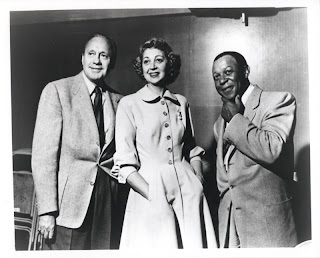A couple of months ago, I wondered whether Jack Benny went back to 39 after celebrating his 40th birthday during a TV special in 1958. Erskine Johnson of the National Enterprise Association provided the answer a year later. Here’s his column:
 HOLLYWOOD, Jan. 9 (NEA) — Life may begin at 40 but the laughs didn’t for Jack Benny who will return to that magic “old” age of 39 when he celebrates his next birthday on TV in February.
HOLLYWOOD, Jan. 9 (NEA) — Life may begin at 40 but the laughs didn’t for Jack Benny who will return to that magic “old” age of 39 when he celebrates his next birthday on TV in February.“Turning 40 was a mistake,” Jack confided when he tipped me off about going back to the age he celebrated for 23 years. “There’s nothing funny about being 40, really. But there is about 39—the hanging on to a certain decade. Our kidding and jokes about being 40 didn’t pay off.”
So Jack will be 39 again in ‘59, but there will be no other format changes on his TV show, which continues to roost in, or just outside of the nation’s Big Ten.
As Jack always puts it:
“What can I change on my show? I never do two shows alike.”
It’s the unexpected, combined with the old Benny character now known to two generations, that has kept Jack & Company at the same old stand while other comedy shows have posted closing notices. But there’s something else, too. Jack likes to point out.
“Working constantly and avoiding nostalgia,” are his words for it.
“I think,” he says, “about today and tomorrow and never about the past.”
Oh, yes, it happens for comedians like Jack, too. Just like it happens to all of us husbands.
Jack went home the other day and told Mary he had just heard a wonderful new joke, which he then told her.
Mary just smiled, benignly.
“Oh, Jack,” she said. “I heard that one three months ago.”
And a month ago, I expressed a bit of scepticism in Jack’s statement to Associated Press columnist Bob Thomas in 1962 that he “can’t worry about the ratings.” Jack most decidedly did worry about the ratings and, once more, he tried to get Bill Paley or someone at CBS to do something about it—and succeeded. Let’s look at some snippets from Johnson’s other columns in 1959.
Buck Benny Wants to Move; No Match for ‘Maverick’
By ERSKINE JOHNSON
HOLLYWOOD, March 15 (NEA) – That “cowardly western” called “Maverick” which gunned down Steve Allen and Ed Sullivan on the rating charts now has the old pro, Jack Benny, pressing the SOS button.
James Garner, Jack Kelly and Co. are competition Buck Benny no longer wants to buck. CBS already has Jack’s ultimatum—a new TV time for next season or else he will pass up his regular show for occasional “specials.”
In another time spot, Jack should have no trouble. But he’s whistling in the dark when he says his long-time 7:30 p.m. Sunday night time is controlled now by young ‘uns at the TV dial. Junior, pop and grandma, too, are watching “Maverick,” Jack.
From April 8th:
Those cold, cold figures for Jack Benny on why he’s bowing out as Sunday night competition for “Maverick.” The March 22 rating on the shows:
“Maverick” 35.2
Jack Benny 11.2
On the same night “Maverick” also gunned down the opposing Steve Allen (14.5) and Ed Sullivan (14) shows.
From June 10th:
Channel chatter: Jack Benny got his wish for a later Sunday night time spot in the fall. He will alternate with George Gobel next season at 10 p.m. according to latest plans.
And a follow-up from July 28th:
Jack Benny will star in three hour-long TV specials for the new season. He’ll still have his half-hour spot on alternate Sundays. George Gobel and not “Bachelor Father” will be the alternate this year. Jack’s first guest star will be Harry Truman, at the piano, you can bet, with Jack fiddling.
Jack’s competition in the 1959-60 season was “The Alaskans” (ABC) and “The Loretta Young Show” (NBC). “Maverick” continued to do pretty well, but not as well as “Dennis the Menace,” which CBS counter-programmed against it. Jack was pushed back a half hour the following season—and ended up back in the top ten before being creamed by “Bonanza” in 1961.







































